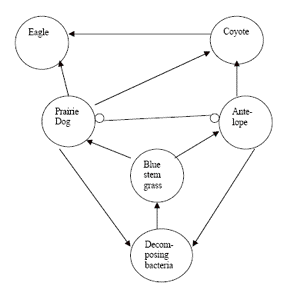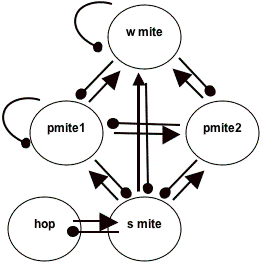

Student Collected Data from this Experiment
Below is an example of a student's responses to the questions on Student Handout 2: Steps for Creating Qualitative Models (*.doc 29KB) or (*.pdf 20KB). This assignment asked questions about prairie ecosystems and was posed in John Rueter's ecology class.
Student Response #1: excerpts from student's handout for Part 1D, steps 1-5.

Figure 22. Sample student model of role of decomposers in grassland ecosystem.
STUDENT ASSESSMENT - basic ecological knowledge (count the number of correct and substantiated links, then subtract the number of incorrect or unsubstantiated links): 9 correct links, no incorrect links, expert score
Step 1. Describe an ecological process.
- Throughout the ecosystem, there is competition for resources (prairie dog and antelope and eagle and coyote), and recycling of nutrients from dead and decomposing plants and animals by the bacteria.
Step 2. Describe flows and feedback.
- The recycling comprises a positive feedback loop. The competition provides a negative loop. The existence of predators constitutes negative feedback loops to the herbivore species, preventing overgrazing of the blue stem grasses.
Step 3. Give your model a name.
- Role of decomposers in prairie ecosystem.
Step 4. What direct and indirect effects may occur from the introduction of a potential new species to your system?
- If an invasive grass species were to enter the system and compete with the native vegetation, it is possible that the populations of both antelope and prairie dogs would become less viable due to lessened availability of more nutritious food.
Step 5. Potential research questions.
- IF an invasive plant species competed with blue stem grass, AND, the antelope population had less nutritious food available, THEN, the antelope population would have to forage over a wider area and decline in number.
STUDENT ASSESSMENT - accuracy of interaction descriptions: Are the interactions modeled accurately and appropriately described in the essay portion of the work sheet? The answers are sufficient, but not expertly answered.
STUDENT ASSESSMENT - overall quality of the model: Make a judgment based upon key model components, e.g., Were the important elements included? Based upon the title provided by the student, is the model adequate? The answers are sufficient, but not expertly answered.
STUDENT ASSESSMENT - Overall score is 5 out of 6 showing at least one expertly answered, one not yet expertly answered (see Description: Assessment #2)
Student Response #2: an example of more advanced responses from Part 2D, steps 4-11:
Step 4. Write down a research question.
- If we plant cover crops, which provide overwintering sites for the predator Neoseiulus fallacis ("pmite 2"), will we be able to then improve the growth of hops in the following years?
Step 5. Using the steps described above in how to use POWERPLAY, generate a model of the possible set of interactions.

Figure 23. Sample student model of a mite community within a hop agroecosystem
STUDENT ASSESSMENT - basic ecological knowledge (count the number of correct and substantiated links, then subtract the number of incorrect or unsubstantiated links): Nine correct links – zero incorrect links = +9 (Excellent)
Step 9A and 9B. Describe ecological processes, flows and feedback, describe main interactions.
- The predator N. fallacis ("pmite 2") preys on the spider mite ("s mite"). This constitutes a negative feedback loop, because increases in the spider mite population spur increases in the predatory mite population due to predator numerical response (positive link), which would in turn cause eventual decreases in the spider mite population (negative link).
- Negative feedback relationships also exist between the spider mite and the hop plant (plant-herbivore relationship), between G. occidentalis ("pmite1") and the spider mite (predator-prey relationship), between N. fallacis and G. occidentalis (intraguild predation), and between the whirligig mite (Anystis sp., "w mite") and each of its three prey types (polyphagous predator — prey relationships).
- Negative self-effect loops represent cannibalistic tendencies in G. occidentalis and the whirligig mite.
- Two examples of feedback loops containing three components are obvious in the model. The first contains links from the spider mite to G. occidentalis (positive), from G. occidentalis to the whirligig mite (positive), and from the whirligig mite back to the spider mite (negative). The second example contains links from G. occidentalis to N. fallacis (positive), from N. fallacis to the whirligig mite (positive), and from the whirligig mite back to N. fallacis (negative). An example of a four-component feedback loop starts from the spider mite to the whirligig mite (positive) to N. fallacis (negative) to G. occidentalis (negative) and back to the spider mite (negative).
- Energy flows from the hops, through the spider mites and up to the predator guild in this community. For the sake of simplicity, this model does not identify mechanisms by which energy is lost as it passes through the trophic levels (e.g. energy lost through digestion of prey).
Step 9C. What name would you give to your model overall? What is the name of the one big ecological idea being described or explored?
- Mite community associated with hop
- Complexity, emergent properties.
Step 10. Calculate community stability, explore the dynamics of your ecosystem model by explaining the significance of these calculations in a paragraph.
- The system was determined to be stable, but in looking at the adjoint matrix (which is summarized by the figures given in the 'press' predictions) along with the weighted prediction matrix, several unexpected predictions were made. These unexpected results (emergent system properties) illustrate the usefulness of this type of analysis. Our original hypothesis (that increasing the density of the predator, N. fallacis, would help to control spider mites and thus improve hop growth) was contradicted by the indications of the analysis. Increasing the density of this mite only had the effect of decreasing the density of another predator, G. occidentalis, which would probably occur at least in part due to the tendency of N. fallacis to attack other phytoseiid mites (interference competition), such as G. occidentalis. Only an increase in the density of G. occidentalis was indicated to cause an increase in hop growth. However, according to the weighted prediction matrix, we cannot be sure this increase will occur; the confidence we can have that the change in hop growth will be positive is only 0.5 on a scale from 0.0-1.0. These weighted predictions are determined by taking the net complimentary feedback (adjoint elements) divided by the total number of feedback cycles (absolute elements).
- Another way we might be able to improve hop growth would be to add fertilizer. An increase in hop growth is predicted to be sustained in the system, but in this case the relevant weighted prediction element is only 0.14. The population of the herbivore is also predicted to increase, but this is apparently checked by a corresponding increase in the whirligig mite.
Step 11. Develop a research hypothesis
- Based on the indications of the qualitative community analysis, we have developed two hypotheses which
could be tested in replicated field experiments:
- Making augmentative releases of G. occidentalis improves the yield of hops.
- Continual applications of fertilizer to the soil improves the yield of hops.
STUDENT ASSESSMENT - A second score is created by assessing how appropriately the student has described the
interactions modeled in the essay portion of the work sheet.
All interactions are explained clearly. In each case, the type of loop (negative feedback loops, self-effect loops) is identified
and explained, and the type of ecological relationship (predator-prey, intraguild predation, etc.) is specified. Excellent.
A third score can be ascribed by making a judgment about the overall quality of the model; i.e., were the important elements included?
Based upon the title provided by the student, is the model adequate?
This is a very good model, but it is somewhat simplified. All models are simplifications, but some critical discussion about factors
that were observed at the field site but that were not included in the model would have improved the write-up. For example, weeds that
compete with the hop plants and other arthropods (e.g. the ladybird genus Stethorus preys on spider mites in this hop agroecosystem)
that might prey on these mites are not modeled. Omitting the weed competitors from the model may result in erroneous predictions, in
particular when applications of fertilizer are considered. The fertilizer will also increase the growth rates of the weeds, which
may result in some degree of increased competition with the hop plants. The title is appropriate; it reflects your focus on exclusively
the mite community.
A combination of these ideas are then scored cumulatively with a 6 point rubric:
6 showing all three expertly,
5 showing at least one expertly answered, one not yet expertly answered
4 showing all sufficient, but just passing, answers
3 not passing, showing only one sufficient, two insufficient
2 not sufficient, but at least an attempt
1 showing an overall poor attempt.
Score: 5
Analysis Skills. Evaluating the quality of students’ research hypothesis.
a) Is the hypothesis stated in such a way that it can be rejected, given contradictory results from a performable test? Does the
student specify what result(s) would need to be observed in order to reject the hypothesis? b) Is the hypothesis contradicted by
any evidence already available to the student?
Hypotheses are focused, reasonable and clearly testable.
Overall grade: A-. Very good work. Critical discussion of factors that were intentionally omitted from the models would have
increased the grade to an ‘A’.